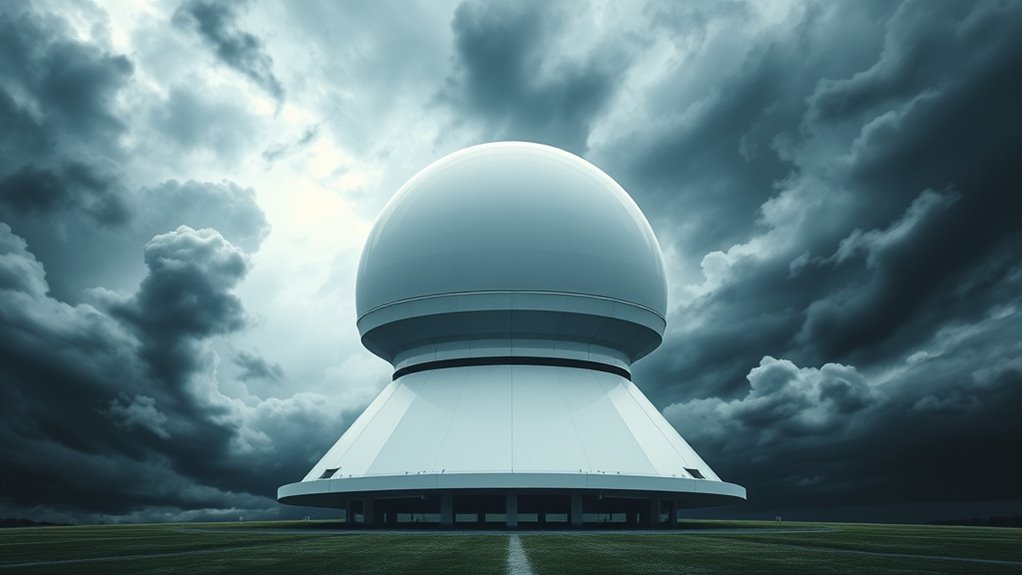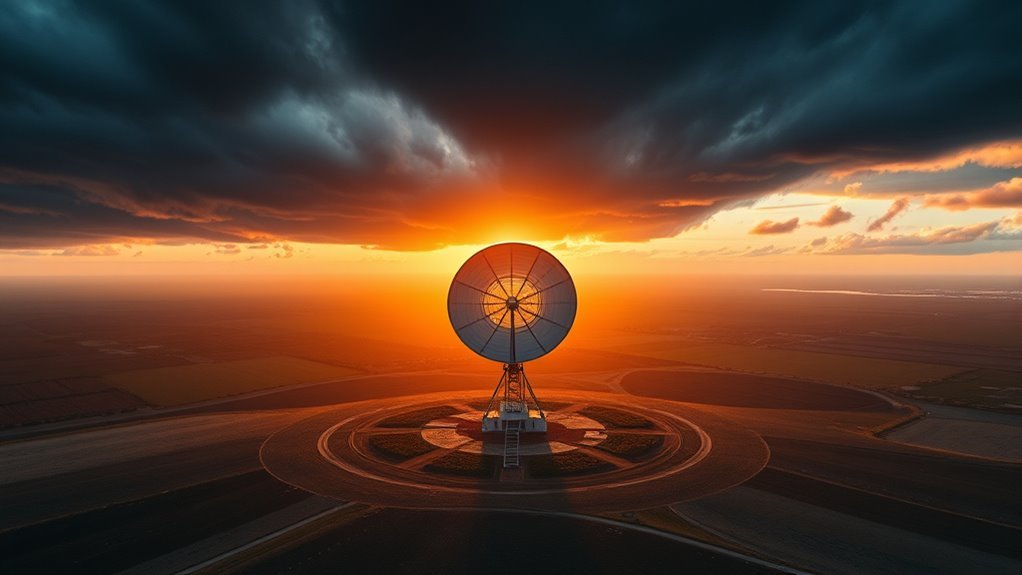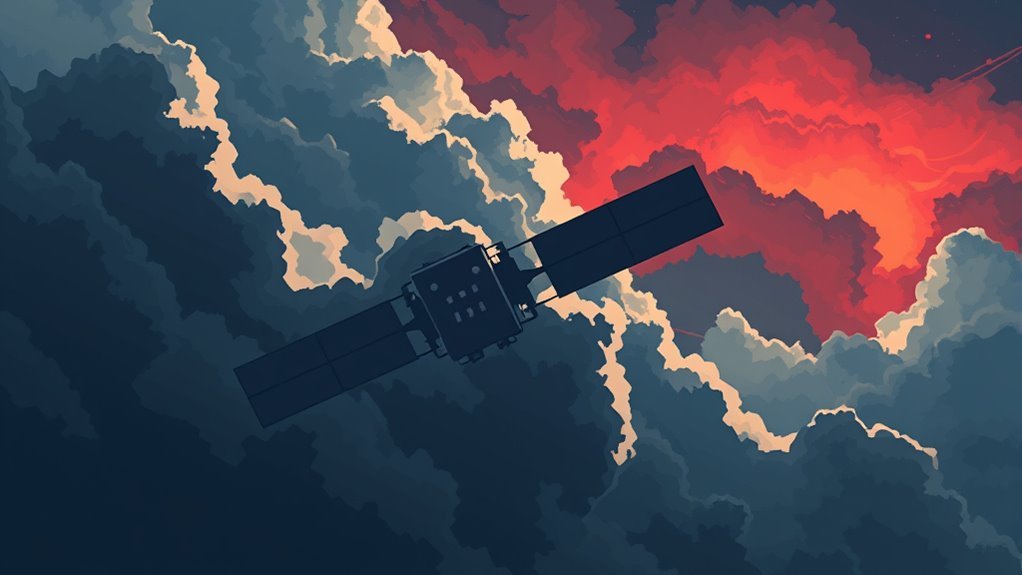Radar and satellite technology are essential for tracking developing squalls. Radar detects precipitation and measures wind velocities, helping to analyze storm intensity. Meanwhile, satellite imagery provides a broad view of atmospheric conditions, including cloud formations and moisture distribution. By integrating both data sources, meteorologists can improve the accuracy of squall detection and forecasting. This collaboration offers understanding into storm behavior and potential hazards. Further exploration reveals more about the predictive models and safety measures in place.
Main Points
- Radar technology detects precipitation intensity and wind velocities, providing real-time insights into developing squalls and their intensity.
- Doppler radar measures wind patterns, enhancing the understanding of squall dynamics and predicting potential hazards.
- Satellite imagery captures large-scale atmospheric conditions, revealing cloud formations and moisture distribution associated with squalls.
- The integration of radar and satellite data improves predictive models, allowing for more accurate squall forecasting and timely alerts.
- Advanced algorithms and machine learning enhance the analysis of atmospheric conditions, increasing the ability to anticipate severe weather events like squalls.
The Science Behind Squalls: What They Are and How They Form
Squalls are sudden, intense bursts of wind that often accompany severe weather conditions, particularly thunderstorms. These phenomena result from the rapid upward movement of warm, moist air, which can create a sharp contrast with cooler, denser air.
As the warm air rises, it cools, leading to condensation and the formation of clouds. This process releases latent heat, further intensifying the upward motion. When the pressure builds up sufficiently, it can lead to a downdraft, causing strong winds to rush downward and outward, resulting in squalls.
Typically, squalls can be brief but violent, lasting only a few minutes to an hour. They can occur with little warning and may produce hazardous conditions, including sudden changes in temperature and visibility.
Understanding the formation and characteristics of squalls is essential for meteorologists and individuals in affected areas, as these events can pose considerable safety risks during severe weather.
The Role of Radar Technology in Weather Monitoring

Radar technology plays an essential role in modern weather monitoring, providing meteorologists with the ability to detect and analyze atmospheric phenomena in real-time. Utilizing radio waves, radar systems emit signals that bounce off precipitation and other atmospheric elements, allowing for the visualization of storm structures and movement. This capability is vital for tracking squalls, as it enables the identification of intense rainfall, wind shifts, and potential severe weather conditions.
The data gathered through radar can be processed to generate detailed imagery, offering perspectives into storm dynamics. Doppler radar, in particular, allows for the measurement of wind velocities, enhancing the understanding of storm intensity and development.
This information is indispensable for early warning systems, enabling timely alerts to be issued, thereby helping communities prepare for impending weather events. Altogether, radar technology serves as a cornerstone in the field of meteorology, enhancing the accuracy and efficiency of weather monitoring and forecasting.
Satellite Imagery: A Bird's Eye View of Atmospheric Conditions
While radar technology provides detailed understandings into localized weather phenomena, satellite imagery offers a broader perspective on atmospheric conditions across large regions. Satellites capture extensive swathes of the Earth's surface, allowing meteorologists to monitor large-scale weather patterns, such as developing squalls, from a unique vantage point. The high-resolution images aid the observation of cloud formations, temperature variations, and moisture distribution, enabling the identification of potential storm systems before they intensify.
Furthermore, satellite data improves the understanding of atmospheric dynamics by revealing the interactions between different weather systems. This all-encompassing view is essential for predicting the movement and development of squalls, as it highlights areas of instability and moisture convergence.
In the end, satellite imagery serves as an indispensable tool in modern meteorology, complementing radar technology by providing essential context and spatial awareness regarding atmospheric conditions across large areas.
Real-Time Data: How Radar and Satellites Work Together

Radar and satellite systems complement each other in providing real-time data for monitoring squalls.
Through radar signal processing, meteorologists can detect precipitation and wind patterns, while satellite imagery analysis offers a broader perspective of atmospheric conditions.
The collaboration between these technologies improves forecasting accuracy and response strategies.
Radar Signal Processing
Integrating real-time data from radar and satellites improves the accuracy of squall detection and forecasting.
Radar signal processing plays an essential role in this integration by analyzing reflected radio waves to determine precipitation intensity, movement, and structure. Advanced algorithms process the received signals, filtering out noise and enhancing relevant features to produce clearer images of weather patterns. This processed data is critical for identifying developing squalls, allowing meteorologists to track their progression and predict their impact.
Furthermore, the combination of radar data with satellite observations creates a thorough view of atmospheric conditions. Consequently, timely and precise information is disseminated to decision-makers and the public, facilitating better preparedness for severe weather events associated with squalls.
Satellite Imagery Analysis
The collaboration between radar and satellite technology improves the monitoring and analysis of squalls, especially through satellite imagery analysis.
Satellite imagery provides a wide perspective, capturing extensive areas and revealing cloud formations associated with developing squalls. These images allow meteorologists to observe real-time changes in weather patterns, augmenting situational awareness.
By integrating satellite data with radar readings, forecasters can assess the intensity and movement of squalls more accurately. Advanced algorithms process this imagery, identifying critical features such as cloud tops and moisture content.
As a result, timely alerts can be issued, ensuring communities are prepared for severe weather. In this way, the cooperation of satellite imagery and radar greatly improves the understanding of squall development and behavior.
Tracking Squall Development: Key Indicators and Patterns
Squall development can be effectively monitored through a combination of atmospheric indicators and pattern recognition. Meteorologists observe changes in temperature, humidity, and wind direction, which are essential for identifying the potential for squall formation. A rapid increase in moisture levels, accompanied by a drop in atmospheric pressure, often signals an impending squall.
Additionally, the presence of specific cloud formations, such as cumulonimbus clouds, can indicate vertical instability and potential squall activity.
Pattern recognition plays a significant role in tracking squalls. Historical data provides understanding into recurring squall patterns, allowing forecasters to anticipate future events. The identification of these patterns, combined with real-time data from radar and satellite technology, improves situational awareness.
Enhancing Forecast Accuracy: The Impact of Advanced Technologies
Advanced technologies greatly improve forecast accuracy through real-time data analysis and better predictive models.
By leveraging these innovations, meteorologists can better anticipate squall formations and their potential impacts.
This heightened precision not only aids in timely warnings but also supports strategic planning for affected regions.
Real-Time Data Analysis
While meteorological forecasting has traditionally relied on historical data, the integration of real-time data analysis has considerably transformed the accuracy of predictions related to squalls.
This advancement allows meteorologists to access immediate information regarding atmospheric conditions, such as temperature, humidity, and wind patterns.
Utilizing data from radar and satellite technology, forecasters can monitor developing squalls as they occur, enabling timely warnings and improved public safety measures.
Real-time analysis also aids the identification of rapid changes in weather systems, allowing meteorologists to adjust forecasts accordingly.
The ability to process and interpret extensive amounts of data in real-time improves situational awareness and contributes to more reliable forecasting, ultimately leading to a notable reduction in the impact of severe weather events on communities.
Improved Predictive Models
The integration of real-time data analysis has paved the way for the development of improved predictive models in meteorology. By leveraging data from advanced radar and satellite technologies, meteorologists can now create more accurate forecasts for developing squalls.
These models utilize algorithms that analyze atmospheric conditions, wind patterns, and moisture levels, allowing forecasters to predict squall formation with greater precision. Additionally, machine learning techniques bolster these predictive capabilities by continually refining models based on historical data.
As a result, the ability to anticipate severe weather events has considerably increased, providing timely warnings that can save lives and reduce property damage. In the end, these advancements in predictive modeling represent a vital step forward in weather forecasting.
Safety Measures: Preparing for Squalls Using Meteorological Insights
Given the unpredictable nature of squalls, effective safety measures can greatly mitigate their impact on both life and property. Utilizing meteorological knowledge, communities can implement advanced warning systems that alert residents to impending squalls. These systems often rely on real-time data from radar and satellite technology, allowing authorities to issue timely advisories.
Public education plays a vital role in safety preparedness. Informing individuals about the signs of developing squalls and appropriate responses can save lives. Additionally, establishing designated shelters and safe zones guarantees that residents know where to go during severe weather events.
Organizations involved in emergency management should conduct regular drills and simulations to prepare for potential squalls. Investments in infrastructure, such as improved drainage systems and reinforced buildings, can also improve resilience against sudden weather changes.
In the end, a proactive approach rooted in meteorological knowledge can greatly reduce the risks associated with squalls.
Common Questions
How Do Squalls Differ From Other Storm Types?
Squalls are marked by sudden, intense wind shifts and brief, heavy rainfall, distinguishing them from other storm types. Unlike hurricanes or thunderstorms, squalls typically develop quickly and dissipate rapidly, causing localized but considerable impacts.
What Are the Limitations of Radar and Satellite Technology?
Radar and satellite technology, while effective for monitoring weather, face limitations such as range restrictions, resolution challenges, and susceptibility to interference. These factors can impede accurate data collection and forecasting, particularly in rapidly changing weather conditions.
Can Squalls Occur Without Radar Detection?
Squalls can indeed occur without radar detection. Factors such as geographical limitations, radar range, and environmental conditions may prevent accurate tracking, allowing sudden squalls to develop unnoticed in certain regions, posing risks to safety and navigation.
How Often Is Real-Time Data Updated?
Real-time data updates occur frequently, typically every few minutes, depending on the technology used. This rapid refresh rate allows meteorologists to monitor weather conditions closely and respond promptly to developing atmospheric phenomena.
What Role Do Meteorologists Play in Squall Prediction?
Meteorologists analyze atmospheric conditions and utilize various tools to predict squalls. Their skill set enables them to interpret data, identify patterns, and issue warnings, finally enhancing public safety and preparedness during severe weather events.

